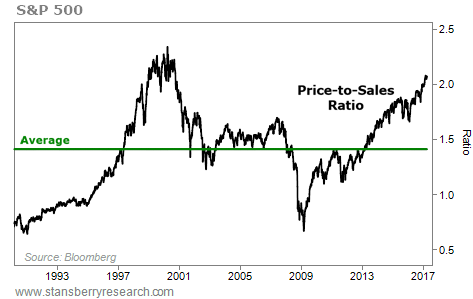Stock Market Warning
Signs of a top are finally starting to show...
WE BEGIN with signs of the top, writes Justin Brill in the weekly digest of Steve Sjuggerud's Daily Wealth email.
Stocks are expensive. But we remain cautiously bullish for now.
Yes, large-cap US stocks are now trading at higher levels than any other time in history, outside of the Internet bubble. But as Porter Stansberry explained in the April 7 Digest, valuation alone is not a reason to get bearish.
"The chart below shows you the ratio between the market value of these companies and their annual sales. This 'price to sales' ratio is one of the best ways to measure the real value (or lack of value) in the stock market because there are ways to inflate other measures, like book value ratios and earnings...

"One vital point to remember, however: just because stocks are extremely expensive compared with history doesn't mean they can't become more expensive.
"I don't advocate shorting individual stocks just because they're expensive in terms of their ratios. Nor do I advocate shorting markets merely because they're expensive relative to history. Valuation doesn't equal timing."
Now, though, we're also starting to see examples of the absurd beliefs that always accompany a top in the market...
History shows investors can come up with all kinds of convincing – but ultimately foolish – reasons why "this time is different."
For example, in the late 1990s, everyone loved tech stocks.
If you were an investor at the time, you may remember people had plenty of reasons why they believed these stocks weren't expensive and could only go higher. Back then, they said profits didn't matter in the "new economy". It was all about "clicks and eyeballs".
In the mid-2000s, everyone loved housing...And there were plenty of reasons to buy. "They aren't making any more land," they said. "And home prices never go down."
We were reminded of this while reading the Wall Street Journal this week. In an article titled, "This Time Is Different: Two Reasons Not to Be Alarmed by the Nasdaq Record," the authors presented a simple argument...
"The companies in the [Nasdaq Composite Index] collectively [trade] at 27.5 times their last 12 months of earnings, according to Thomson DataStream.
"While that's the highest such reading for the multiple since 2004, it just barely eclipses levels seen in early 2010. And it's only a fraction of the peak of 72.2 seen in March 2000, when euphoria over tech stocks crested.
"The current valuations, though high relative to much of the post-crisis economic recovery, suggest that the recent climb in share prices hasn't gotten out-of-whack with recent earnings. This time really is different. So far."
In other words, tech stocks aren't that expensive because they're still cheaper than they were at the peak of one of the biggest manias in history.
How's that for an investment thesis?
Meanwhile, we're also keeping a close eye on the looming problems in the credit markets...
In recent months, we've shown how default rates for auto loans, student loans, and even high-yield "junk" corporate debt have been quietly ticking higher.
Now, we have new evidence that one of the riskiest corners of the credit markets is rolling over, too...
Last week, Capital One Financial (COF) – one of the country's largest credit-card lenders – reported first-quarter earnings. And they weren't good...
The firm reported a stunning 20% year-over-year decline in net income, far worse than analysts had predicted. And it said larger-than-expected credit-card losses were to blame. As the Journal reported...
"The bank, often looked at by analysts as a gauge of consumers' ability to pay back their debts, reported that domestic credit-card net charge-offs reached 5.14% in the first quarter. [This] was up from 4.16% a year prior. The companywide provision for credit losses jumped 30% from a year earlier to $1.9 billion."
Porter and his Stansberry's Investment Advisory team predicted this trend more than a year ago...And it is likely just getting started.
As they explained in the December 2015 issue, where they warned about the rising risks to credit-card lenders for the first time...
"Like the financers of subprime auto and student loans, Capital One's margins depend on low cost of capital and keeping loan losses to a minimum. If either one of these numbers rise significantly, profits can evaporate quickly. Our bet is that the company's credit-card loan losses are about to start rising..."
Back in 2007, credit-card loan losses for Capital One totaled around $3.6 billion. In 2008, losses nearly doubled to $6.1 billion, wiping out the company's entire profits. The stock plunged from around $83 in 2007 to $8 a share by March 2009.
Capital One's credit-card loan losses reached 8% of its loan book in 2008. Today, its loan losses are half that at around 4% for credit-card loans...We expect they will head much higher. They could approach 10% of the company's loan-book value. When this happens, Capital One's profits will disappear...once again.
Unfortunately, Capital One's own management team still doesn't appear to understand the magnitude of these problems. More from the Journal...
"Chief Executive Richard Fairbank said the bank raised its outlook for full-year, domestic card charge-off rates to the high end of a 4%-to-around 5% range. That was up from the bank's prior expectation of the mid-4% range. Mr. Fairbank said this revision is "based on portfolio dynamics and industry conditions [the bank] observed in the first quarter."
"Against this backdrop, we have been tightening our underwriting," he added. "We still see growth opportunities in our domestic card business, but our growth window is gradually getting smaller."








 Email us
Email us